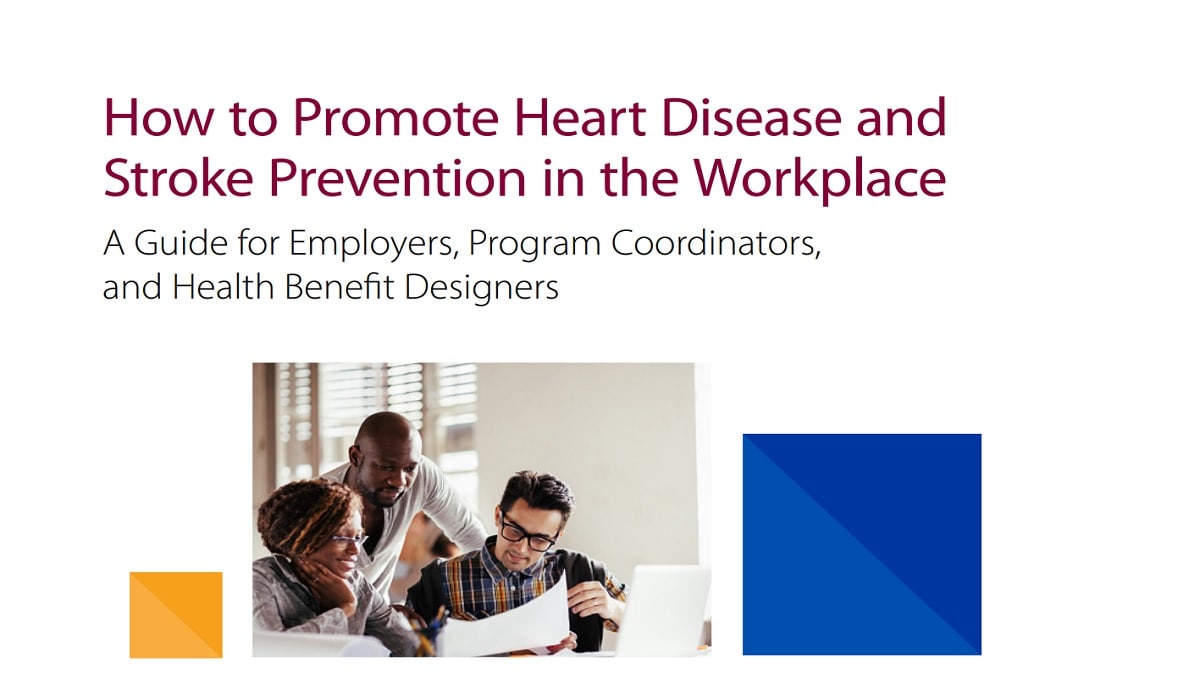At a glance
In 2022, CDC developed How to Promote Heart Disease and Stroke Prevention in the Workplace (called the Employers' Guide for short). This guide can help employers from organizations of all sizes and in all industries start a new workplace health promotion program or improve an existing one.

What is the Employers’ Guide?
Organizations can use the Employers' Guide's information and resources to plan, put into action, and evaluate a program that helps improve their employees' heart and brain health.
By focusing on high blood pressure control and high cholesterol management, the Employers' Guide provides employers with:
- A description of the four main steps of a coordinated approach to workplace health: assessment, program planning and management, implementation, and evaluation.
- A discussion of relevant federal and state workplace health policies.
- Additional resources to help start or improve a WHP program.
Who should use the Employers' Guide?
The Employers’ Guide is intended for all employers, ranging from small to large businesses and across all types of industries. It can be used by staff who hold roles in executive leadership, workplace health promotion, and employee benefits management, such as program coordinators and health benefit designers.
Why are workplace health promotion programs important?
Heart disease and stroke are leading causes of death and disability and the most expensive medical conditions for businesses in the United States.12 Together, heart disease and stroke have led to billions of dollars spent on:
- Direct costs, including coverage for health care services and medicines.
- Indirect costs, including lost productivity associated with absenteeism and presenteeism and short- and long-term disability.3
These conditions are preventable. Employers that work to prevent them can make their workforces healthier and more productive and reduce their health care expenditures.
The workplace has increasingly become a focus for heart disease and stroke prevention efforts. On average, people in the United States spend more than one-third of their waking hours engaged in their work.4
Employers can take an active role in promoting employee heart and brain health by implementing best practices for lowering employees' risk for heart disease and stroke. WHP programs that focus on preventing heart disease and stroke can be integrated into an organization's structure at all levels, through leadership prioritization, programmatic efforts, and health benefit design. They can also be used by all types of employers, ranging from small to large businesses and across all types of workers.
- Centers for Disease Control and Prevention. Multiple Cause of Death, 1999–2020. CDC WONDER Online Database. Accessed February 1, 2024.
- Koffman DMM, Goetzel RZ, Anwuri VV, Shore KK, Orenstein D, LaPier T. Heart healthy and stroke free: successful business strategies to prevent cardiovascular disease. Am J Prev Med. 2005;29(5, Suppl 1):113–121.
- Goetzel RZ, Henke RM, Tabrizi M, et al. Do workplace health promotion (wellness) programs work? J Occup Environ Med. 2014;56(9):927–934.
- Linnan LA, Cluff L, Lang JE, Penne M, Leff MS. Results of the Workplace Health in America survey. Am J Health Promot. 2019;33(5):652–665.
